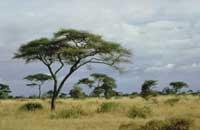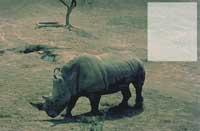African parks: wind change
It seems that the topical image of the white man in shorts, who has worked in defense of the environment in Africa, is in recent times. WWF veterans have recognized that the way to work so far cannot last long and that to achieve sustainable conservation it is necessary to leave more responsibility to its inhabitants, although this may pose a risk. Without these changes, WWF fears that its inhabitants will oppose, annoy the authorities and endanger the long-term conservation of some species on the continent.

At the annual meeting held in November in Switzerland by WWF International, it was argued that reducing the participation of external entities is appropriate to the overall situation. This new strategy will exclude prestigious WWF scientists and conservationists from their work for many years. As an example, it is worth mentioning Smith, a marriage known for his hard work in defense of the white rhino against poachers, who after fourteen years in the Garamba National Park, a 500,000 hectare rainforest in northwest Congo, have had to abandon their work.
In the words of Claude Martin, CEO of WWF International about these changes, in the past, WWF and other groups, "unfortunately, a single association, or even a single person, have formed the image that they can be the only guardians of the species" and "the survival of the species cannot be based only on one or two people".
WWF's new approach, with many supporters, raises the need to return wildlife management to local communities so that it is not only in the hands of white man. Thus, among the main priorities of the Wildlife Conservation Society, based in New York, are, for example, the momentum of local African mountain researchers and the breakdown of barriers between people and animals. In Zambia, for example, this association aims to "help locals make decisions about the sustainable use of wildlife." In Kenya, however, they have focused their attention on mitigating conflicts between peasants and animals outside the park, especially elephants, zebras, giraffes and other herbivores.
Seen with a bit of pragmatism, it is clear that the mere participation of local populations in the conservation of wildlife will not prevent the effort to get skins and horns enriching corners of poachers, especially outsiders. However, WWF's hope is that the above idea is an impulse to attract locals to government initiatives such as free closures to protect animal fields. In this way less animals would be thrown and a good relationship with conservationists can make it easier for locals to also notify poachers.
This new conservation model was agreed last February by Kinshasan Martin and the new president of the Congo, Laurent Kabila. The goal is to put things in the hands of Garamba and the other territories in Congo. WWF will support them in policies and technical issues such as developing action plans for biodiversity. Therefore, more emphasis will be placed on policy to the detriment of isolated mountain activities.
According to the WWF authorities, more diplomacy and less direct action are the only hope of conservationists to keep these territories in good condition in the long run. Precisely, WWF leaves the jungle and adapts to the offices of the capitals. Rwanda, the Central African Republic and the new projects of the South African Republic also reflect this change.
The driving force behind these new strategies was Martin himself, who in 1994 was appointed Managing Director to replace the more traditional South African Charles de Haes. The reasons are partly economic, as it is costly for a foundation or association to fulfill the tasks of local governments and assume wages, supplies of material, etc. However, they are also political and philosophical motives.
The example of Madagascar is representative. In the territory there was an incomparable wildlife, but farmers and sawmills caused a strong deforestation and the need to work in the care of what was left. WWF began its activity and in 1986 sent two experts, a decade later 600 local workers. The Association became the substitute for government authority, not intentionally, but by gravity. But this does not seem timely and now some responsibilities are being withdrawn.

In any case, this political change has generated numerous debates, even within WWF, although the most demanding criticisms have come from other associations. According to the Africa Conservation Centre in Nairobi, the expulsion of the Smith in the name of the need for conservation to be carried out by people in the area means the extinction of the northern white rhino. According to them, the results of the project (Garambakoak) have been spectacular, but only thanks to these two people.
In fact, while they have worked, the number of specimens of this subspecies has increased from 13 to 30 due to good management and disinterested politics with the park. It is not a matter of questioning the good intention of this change of strategy, but they consider this "politically adequate" approach ineffective in many places. They would prefer to see in this type of territory "forces of military appearance" to put order and end the poachers. However, WWF, at the beginning of the year, ordered for ethical reasons that the association not buy more weapons or hire security companies.
On the other hand, there is the association Conservation International, specializing in the purchase and conservation of tropical rain forests. This has recently spent $9 million to buy 1.6 million hectares of forests in central Suriname. This rainforest of tropical rain, not exploited or populated, has been purchased to be deposited in biodiversity. According to this powerful association, the only one with good results is the traditional vision of conservation. This association has called for unconditional conservation and has denounced that groups with a more pragmatic approach are full of people against conservation.
In his opinion there is no evidence, or few, that the "sustainable" exploitation of the rainforest truly guarantees both biodiversity and the number of trees. In any case, uninhabited forests are not common in Africa and, based on the current WWF vision, barriers must be broken and poachers forced to change their minds instead of shooting. It's a new challenge and sometimes things don't go the way they want, but they believe that we have to deal with the dangers of sustainable conservation, which have been driven by the most innovative winds. Now you have to see what is going to be imposed in this wind fight.
Buletina
Bidali zure helbide elektronikoa eta jaso asteroko buletina zure sarrera-ontzian











